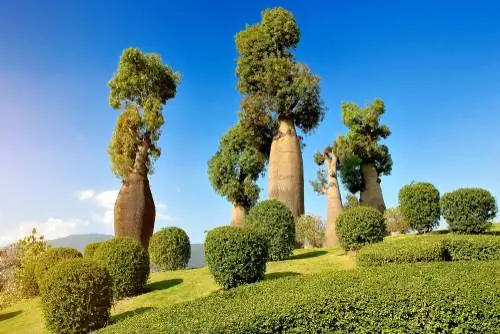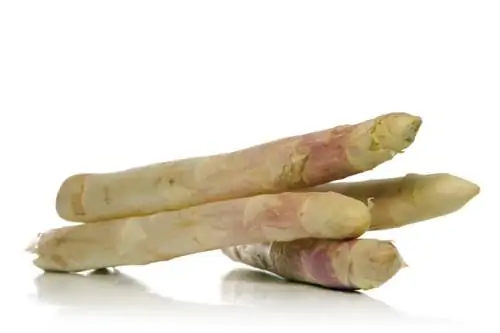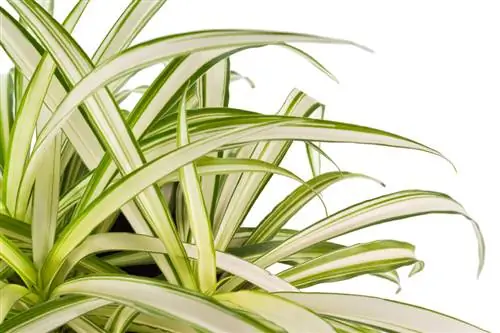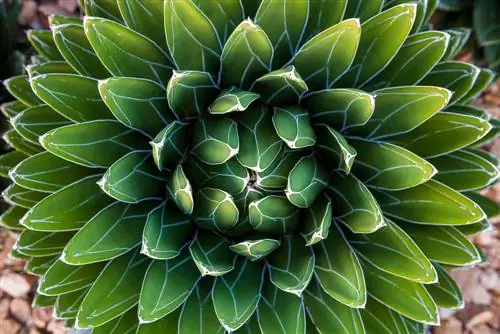- Author admin [email protected].
- Public 2023-12-25 17:45.
- Last modified 2025-01-23 11:21.
The Australian bottle tree (bot. Brachychiton rupestris) is usually sold as a lucky tree in this country. It has a high ornamental value due to its bizarre growth and is also considered robust and easy to care for. It should not be confused with the elephant's foot (bot. Beaucarnea recurvata), which is also known as the bottle tree, but is a species native to Central America.

What is a lucky tree and how do you care for it?
The lucky tree (Brachychiton rupestris) is an Australian plant with bizarre growth and high ornamental value. It requires a sunny location, well-drained substrate and moderate watering. It is robust and easy to care for, ideal for beginners and as a houseplant.
Origin and distribution
We offer the Australian bottle tree (bot. Brachychiton rupestris) under the common name lucky tree. This species, which belongs to the Sterculia family and grows up to 25 meters high in its natural habitat, is related to the cocoa tree, but originally comes from Australia. The evergreen tree with its bizarre appearance is particularly widespread in the Australian state of Queensland - and has proven to be extremely useful for thousands of years. The succulent plant stores water in its trunk, which is used by hikers in dry times orCan be used as a drinking water reservoir in emergencies. In addition, plant parts such as seeds, leaves and roots are traditionally prepared as food by the native Aborigines.
Specimens available here as houseplants do not come from Australia, but primarily from Israeli breeding. Furthermore, the elephant foot, which is also popular as a houseplant, is also known as the bottle tree, but this tree, which comes from the dry forests of Central America, is a succulent species from the genus Beaucarnea within the asparagus family (bot. Asparagaceae).
Usage
Due to its origins, the lucky tree is not hardy here and can therefore only be cultivated in pots. The plant can be kept very well as a houseplant all year round, but also feels very comfortable in a sunny and dry spot on the balcony or terrace during the warm summer months.
Appearance and growth
The lucky tree, which is botanically correctly referred to as the narrow-leaved bottle tree (bot. Brachychiton rupestris) or, due to its origins, the Queensland bottle tree, belongs to the mallow family (bot. Malvaceae). In addition to the species, the genus of bottle trees (bot. Brachychiton) includes around 30 other species with very different growth and height. In addition to the bottle tree, the related Australian flame tree (bot. Brachychiton acerifolius) is also often cultivated as an ornamental plant.
The succulent lucky tree has a bizarre growth, which is noticeable due to a trunk that is up to 3.5 meters thick at chest height - of course only in its natural state, because when cultivated in a container, the tree grows between ten and 25 meters high about two meters significantly smaller. However, it can also grow quite large in the living room, which is often only noticeable some time after purchase: Since the plants are planted in particularly narrow pots before being sold and treated with growth-inhibiting agents, in many cases they begin to grow strongly after the first repotting grow.
Leaves, flowers and fruits
The green leaves are simple or divided and have one to several leaf blades that can be up to eleven centimeters long and up to two centimeters wide. The cream-colored flowers appear in their natural habitat between September and November, but are rarely cultivated indoors. The elongated fruits ripen from November to May.
Toxicity
The species Brachychiton rupestris is considered non-toxic and can therefore be cultivated safely in households with small children and pets.
Which location is suitable?
The home region of the bottle tree is subtropical to tropical Australia, where it can rain heavily during the rainy season - but this is always followed by a long dry period. The trees can tolerate short-term light frost down to around minus seven degrees Celsius. The lucky tree feels most comfortable in a location that is as sunny, warm and protected from drafts and cold rain. In the apartment, the bottle tree belongs directly next to a sunny window, which is preferably south-facing. However, if the plant is further inside the room or there is no south-facing window, additional lighting can absorb the lack of light.
If you want to cultivate the plant in the living room in winter and outdoors during the summer months, you should slowly and step by step accustom it to its new location in the garden or on the terrace/balcony from around the end of May. Don't leave them outside overnight, but put them back in the living room at least overnight for the first few days. In very exposed locations, you should not immediately expose the lucky tree to the blazing sun - especially around midday - as this often leads to damage from sunburn. Here too, it makes sense to get used to the new location gradually.
Substrate and drainage
Cactus soil has proven to be well suited to the special needs of the succulent lucky tree. You can also mix these yourself from humus soil and coarse sand. In addition to a well-drained substrate, reliable pot drainage is also important, as the plant, which is native to drought regions, cannot tolerate waterlogging. The planter should therefore have a drainage hole at the bottom of the pot so that excess irrigation water can be removed promptly. You can also add a one to two centimeter thick layer of expanded clay at the bottom, which ensures the necessary water drainage.
Watering the lucky tree
The main principle when watering the lucky tree is: It's better to keep it dry than moist! After all, the plant comes from very dry regions, which is why the root base, which is shaped like a bottle, has developed into a water reservoir as it adapts to the environment. Therefore, water only moderately during the hot summer months and very little during the cold season. Instead, the bottle tree tolerates short-term dry phases very well, which is why holiday care is basically not necessary. During particularly hot days, you can do your plant something good by spraying its leaves with a fine pollinator.
Fertilize the fortune tree properly
Between April and September, you should supply the lucky tree with a liquid fertilizer for green or house plants every two weeks, which you should administer together with the irrigation water. However, use the nutrients moderately, as over-fertilization can quickly weaken the tree. After transplanting in spring, fertilization can be omitted for a few weeks if you use pre-fertilized substrate.
Cut the fortune tree correctly
The lucky tree does not need to be cut back. You can only carefully remove brown leaves from time to time. In principle, pruning is possible by removing the shoot tips of the tree. On the other hand, if you just let it grow without resorting to scissors, the plant will sometimes start to bloom after a few years and show pretty pink bell-shaped flowers.read more
Propagate fortune tree
The easiest way to propagate the lucky tree is through cuttings that you cut in spring:
- Cut off the shoot tips about ten centimeters long.
- Dip the cut ends in a rooting powder.
- Plant the cuttings individually in pots with growing medium.
- Keep this slightly moist at all times.
- Put a translucent film over the pot.
- Alternatively, cultivate the cuttings under glass.
- This keeps the air evenly moist, which promotes root growth.
- However, ventilate daily.
- Transplant the young lucky trees into cactus soil as soon as the first new shoots appear.
Alternatively, you can also purchase seeds from specialist retailers and use them for your own sowing. However, it is important to have patience and a lot of sensitivity.
Wintering
During the winter months, the bottle tree benefits from a resting phase at around 12 to 15 degrees Celsius, at which it stops growing and only needs a little water. Therefore, from around September onwards, slowly reduce the amount of water and finally only water the plant little by little. Do not fertilize the lucky tree at all during this time and only start adding fertilizer again when the first new shoots appear. In principle, warm overwintering in the living room is also possible, but then thin, weak shoots often form.
Diseases and pests
The lucky tree is a real beginner's tree, after all, the undemanding plant won't take offense to care mistakes so quickly. The only problem is waterlogging, which is why you should always add a thick drainage layer to the bottom of the pot when repotting. This ideally consists of expanded clay or pebbles. In addition, excess irrigation water should never remain in the planter or saucer. If brown leaf tips appear, the humidity is too low. You can easily increase it by spraying the lucky tree with a sprayer.
Tip
The lucky tree can also be trained very well into bonsai. As such, the plant looks particularly good thanks to its winding roots, which develop due to the typical position in flat bowls.
Species and varieties
In addition to the Australian bottle tree, the money or penny tree (bot. Crassula ovata) is often sold under the name lucky tree. This thick-leaf plant, which comes from South Africa, is a popular, easy-care houseplant and can grow up to one meter high if cultivated well.
Externally quite similar is the elephant's foot (bot. Beaucarnea recurvata), which comes from Mexico and is also often referred to as a bottle tree - but is not related to the Australian bottle tree. The elephant foot is also very robust, long-lasting and the ideal beginner plant.
If you are looking for something special, then the flame tree (bot. Delonix regia), also known as flamboyant, could be the right houseplant for you. The tree, which comes from Madagascar, impresses with its bright red flowers, which is also where it gets its name. The Australian flame tree (bot. Brachychiton bidwilii or Brachychiton acerifolius) also develops magnificent red flowers and is very suitable for pot cultivation.
What all of the species listed here have in common is that they are easy-care succulents that do not die immediately even if they are absent for a long time.






